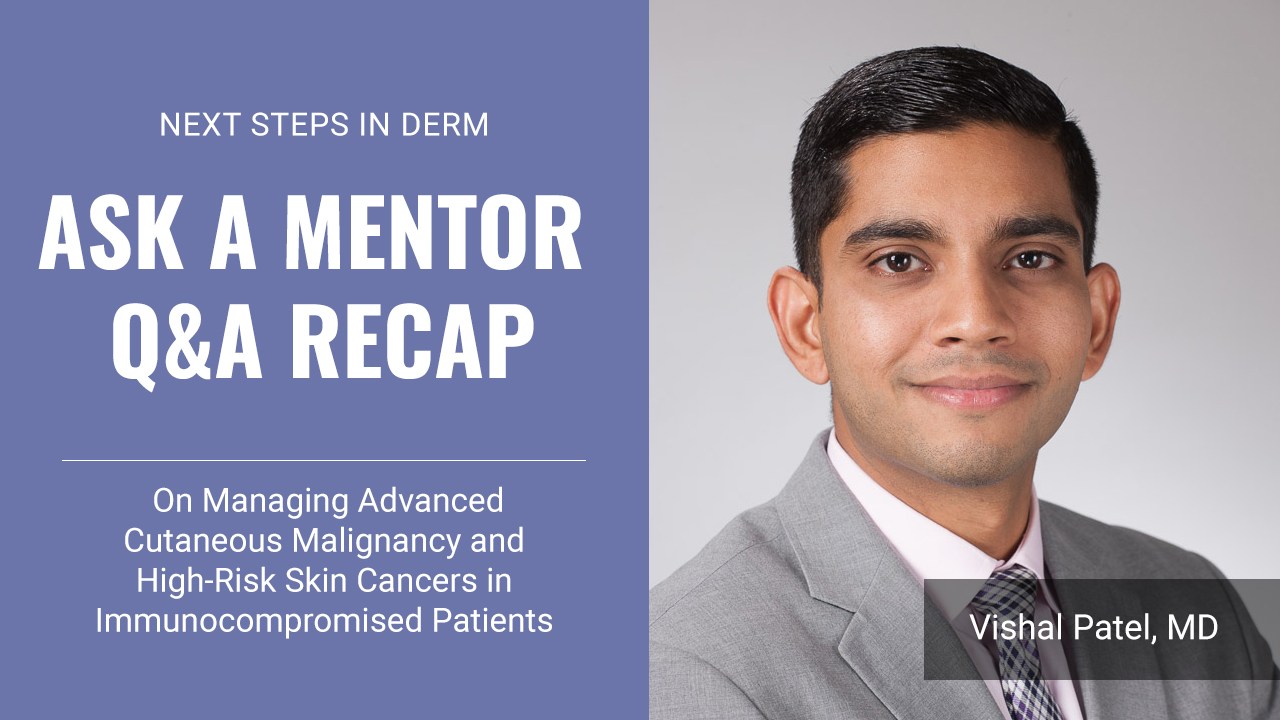Next Steps readers had the opportunity to ask Dr. Vishal Patel questions on managing advanced cutaneous malignancy, high-risk skin cancers in immunocompromised patients, and the importance of certification in Mohs Surgery. See all of his insightful answers below.
What leadership positions are available for dermatology residents interested in pursuing a Mohs fellowship?
There are a variety of leadership positions for residents in local and regional dermatologic societies, the AAD, the ASDS, and the ACMS. There are also leadership positions for residents outside of specialty specific societies like in the AMA. But you can also find opportunities within your training programs in the GME as well.
Is it common and routine to stage SCC and BCC as stage 1, stage 2, etc.?
Historically, staging of BCC and SCC has not been done. However, in recent years there has been a push for systematic staging. It is something that I advocate dermatologists to do. BCC is rarely staged as lesions are generally cured with treatment or lesions rarely metastasize, therefore staging for determining prognosis is rarely needed. However, for SCC, staging can play an important role in determining if a lesion is high risk for poor outcomes (recurrence, nodal metastasis or death). Providers should begin to familiarize themselves with how to stage SCC and what risk factor upstage tumors. This will generally only be relevant for approximately 5-10% of SCCs one will encounter, but you will provide much better patient care by doing so.
Could you please discuss on how to stage SCC and BCC (pet scan, histopathological staging)?
Staging of SCC and BCC are done using either the Tumor (T) Node (N) and Metastasis (M) system of the American Joint Committee on Cancer (AJCC). The 8th edition was recently published and has guidelines on how to stage tumors. Staging generally focuses on the T characteristics and risk factors, so most staging is clinical or histopathologic. Occasionally, radiologic imaging (CT or PET-CT) or sentinel lymph node biopsy is utilized to stage certain high-risk patients or tumors.
What is the next step for patients with cSCC and palpable lymphadenopathy?
In general, any patient with palpable lymphadenopathy requires a full evaluation for nodal metastasis. This will include but is not be limited to radiologic imaging (CT or PET-CT), FNA of the lymph node, and potentially lymph node dissection for histologic evaluation. Following the work up and potentially surgery, adjuvant radiation and/or chemotherapy may be considered in the patient.
What is the role of sentinel lymph node biopsy in cSCC?
This is a controversial topic and an area of significant research. Many institutions utilize sentinel lymph node biopsy in certain high-risk tumors to evaluate for microscopic nodal spread. Other institutions are awaiting trial data to know if it improves outcomes and survival to do so. This is an interesting area of research.
What’s your daily clinical volume? Is it significantly less than that of a general dermatologist?
My daily clinical volume is variable compared to a general dermatologist. As a surgeon, I may see fewer patients overall per day since I am doing surgery but may have longer or more variable hours due to the unpredictability of surgical cases.
What are your thoughts about the need of board certification in Mohs micrographic surgery?
I am highly supportive of board certification in Micrographic Surgery and Dermatologic Oncology. I believe this helps recognize the importance of fellowship training and highlights the depth and breadth of experience of a fellowship trained surgeon. But most of all, I believe this helps provide consistent high-quality care to patients by establishing baseline expectations and standard of care that comes with board certification.
What is the toughest part of working with immunocompromised patients?
The toughest part of working with immunocompromised patients is that each one is different. They each have different immunosuppressive regimens, different past medical and family histories, and different history of UV exposure. Because of this variability, it can be difficult to manage their skin cancer burden and aggressive lesions with any standardized approach. There is a nuance and some troubleshooting that goes into managing these patients.
Are there any situations in which you think Mohs surgery should not be performed even when it is an effective course of action?
Every patient should be considered on a case by case basis. And just because Mohs surgery can be done, does not mean it should. In certain elderly patients, and in certain tumor types, Mohs surgery may not be the most prudent of courses. I especially think that certain sBCC and SCCIC that may qualify under the Appropriate Use Criteria (AUC) for Mohs surgery should initially be treated with topical field or immune therapy with success, reserving surgery for non-responders or recurrences without causing significant harm to the patient.
How do you inform patients of the possible aftermath of undergoing Mohs surgery? Do you involve their families?
All patients undergoing Mohs surgery should have discussion of the procedure, anticipated outcomes, potential reconstructive options, and postoperative course. I have a consultative discussion with all patients prior to or on the day of surgery to make sure they understand all these pieces. If necessary, with elderly patients, family members can be involved who may help care for the patient or if a decision about a more complicated tumor needs to be made.
Did you enjoy did post? Find more on Career Development here.

